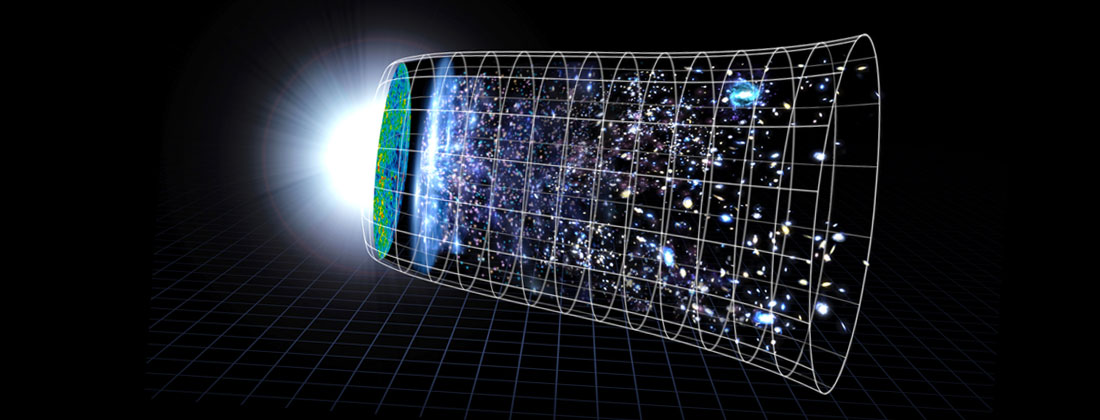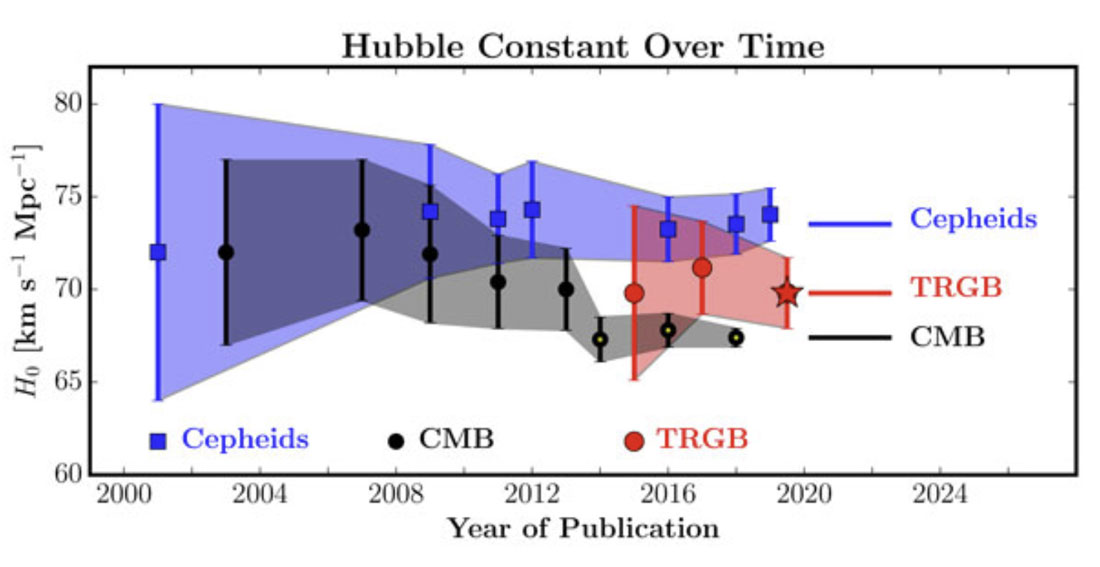Cosmology
At DARK, one of our focuses is resolving the Hubble constant tension, a significant disparity in its measured values. We explore theoretical solutions, such as early dark energy, through various cosmological observations.

We work to improve the accuracy of type Ia supernova models and employ alternative calibration methods like Surface Brightness Fluctuations (SBF).
Additionally, we use gravitational wave cosmology, specifically "standard sirens," to independently measure the Hubble constant. Our research also delves into non-standard scenarios for cosmic acceleration and contributes to upcoming cosmological surveys like LSST and Euclid.
The Hubble constant tension is a strong discrepancy between the Hubble constant measured from observations of type Ia supernovae calibrated with Cepheids and the Hubble constant derived from the cosmic microwave background radiation in the framework of the standard LCDM cosmological model.
The tension may signify an anomaly of the standard cosmological model or a strong hidden systematic effect in either of the two measurements. Hypothetical cosmological solutions to the Hubble constant tension requires involving new physics such as early dark energy.
One of the focuses of our research is to study critically these theoretical proposals in the context of multi-probe cosmological observations. In terms of ongoing searches of possible systematic effects, we are working on improving the current models of type Ia supernova standardisation whose currently insufficient accuracy is the main source of possible systematic errors in the local determination of the Hubble constant.
A big effort is also put into carrying out new measurements of the Hubble constant based on observations and methodologies which are independent of those behind the Hubble constant tension. Examples include observations of gravitational time delays of lensed supernovae, gamma-ray attenuation effect and multi-messenger observations of kilonovae.

DARK researchers have also taken the lead in determining the Hubble constant based on an alternative calibration of type Ia supernovae and on improving our understanding of the progenitor systems and explosion mechanism of SNe Ia.
- https://ui.adsabs.harvard.edu/abs/2021A%26A...647A..72K/abstract
- https://ui.adsabs.harvard.edu/abs/2018A%26A...611A..58G/abstract
- https://ui.adsabs.harvard.edu/abs/2022MNRAS.515.2790W/abstract
- https://ui.adsabs.harvard.edu/abs/2019ApJ...885..137D/abstract
- https://ui.adsabs.harvard.edu/abs/2020A%26A...639A..57A/abstract
- https://ui.adsabs.harvard.edu/abs/2023arXiv230201906W/abstract
Radek Wojtak, Jens Hjorth, Christa Gall, Jacob Hjortlund, Nandita Khetan
Adding towards the efforts of resolving the Hubble tension, one of the explorations at DARK engages in developing an alternate method for calibrating the supernova Ia distance ladder so as to understand possible systematics and biases that might affect the Hubble constant estimate.
We use Surface Brightness Fluctuations - a method to measure distances primarily to old elliptical galaxies in the local Universe, to calibrate the luminosity of supernova Ia. This kind of methodology provides a complimentary calibration to the normally used Cepheids stars, with comparisons providing useful insights into possible systematics.
This kind of alternate pathway with different kinds of galaxies than Cepheid also offers a way to understand the dependance of supernova luminosity of its host galaxies, an important source of systematics in distance ladder approach. With JWST, one can measure precise distances to galaxies using the SBF method which will greatly augment the calibration sample and make this approach extremely useful in terms of the Hubble Tension scenario.
Radek Wojtak, Jens Hjorth, Christa Gall, Luca Izzo, Nandita Khetan
The spectacular success of GW detections in the recent years has heralded the new era of GW cosmology with the first ever measurement of the Hubble constant using these ’standard sirens’ - a method completely independent from the conventional distance-ladder approach.
GWs offer us a breakthrough opportunity to resolve the Hubble tension and understand the expansion of our Universe. The amplitude of a GW signal depends on the distance D to its source, and one can determine physical parameters along with the D of such events by modelling them with binary coalescence models.
On the other hand, the redshift (z) of the source can be measured with direct detection of the electromagnetic (EM) counterpart of the merger or its host galaxy (a.k.a bright sirens). In cases when no counterpart is detected, i.e. a dark siren, the redshift is inferred with a statistical approach using the ensemble of galaxies in the area covered by the sky localization region of the GW signal.
With the upgraded ground-based GW network of LIGO and Virgo observatories recently augmented by KAGRA and later this decade by LIGO-India, the population of both bright and dark sirens is expected to increase dramatically, along with improved sky localisation of the detected events. This would be complemented with advanced optical imaging surveys like the Rubin Observatory and large-scale spectroscopic galaxy surveys like the Dark Energy Spectroscopic Instrument (DESI) which will make valuable contributions in exploiting the cosmological potential of GWs.
Researchers at DARK, in collaboration with the Astro group at University of Queensland, Australia are actively involved in advancing this new possibility by developing methodologies aimed at increasing the precision of estimated Hubble constant using both Dark and Bright sirens.
Nandita Khetan

Understanding the physical nature of accelerating expansion of the universe is one of the main challenges of cosmology. We are exploring non-standard physical scenarios in which the cosmic acceleration described by a cosmological constant is an emergent phenomenon rather than a manifestation of an additional energy component of the universe.
Using multi-probe observational data, we test potential anomalies of the standard cosmological model as signatures of various theoretical scenarios. We are involved in upcoming cosmological surveys including LSST and Euclid.
Radek Wojtak, Steen Hansen
